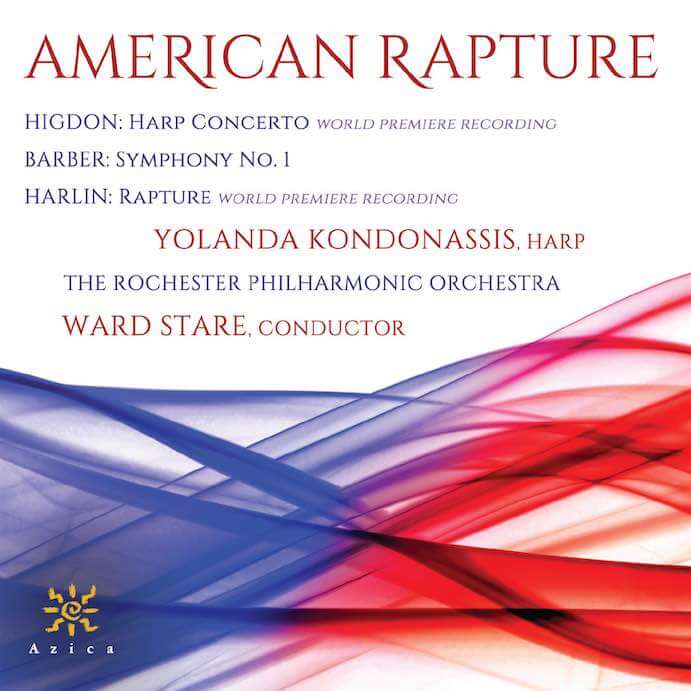American Rapture, the new release on the hitherto unknown to me Azica label, features Samuel Barber’s “Great American Symphony” contender Symphony # 1 (1936) and two world premiere recordings; Patrick Harlin’s Rapture (2011) and Jennifer Higdon‘s Harp Concerto (2018) written for Yolanda Kondonassis. This generous and interesting program explores three generations of American music, and it is wonderful to realize that the USA’s music tradition has been around long enough for such a comparison. The Rochester Philharmonic Orchestra is ably led by its music director Ward Stare, who was the long time resident conductor of the St. Louis Symphony Orchestra.
Jennifer Higdon states in the comprehensive notes that she “loves to write concerti.” And she does, with an impressive line-up including works for oboe, low brass, percussion, violin, and viola, to name a few. The harp concerto was written for a consortium of orchestras and was premiered by this album’s forces. This is not “up to the minute” contemporary music, even though it received its world premiere in May 2018. Higdon’s Harp Concerto is resolutely tonal and lyrical. She explores the lyrical harmonic and rhythmic possibilities of the harp, but not to the cutting edge.
Jennifer Higdon (photo: J.D. Scott)
The first movement, subtitled “First Light,” begins with a crystalline harp solo leading to a lyrical climax. The harp plays almost continually, providing a shimmering background in addition to being in the forefront. “Joy Ride,” the second movement, is short scherzo intermezzo. The third movement, “Lullaby,” reduces the orchestra to a chamber ensemble with the glittering, flowing harp interacting with solo instruments of the orchestra. The movement is reminiscent of Debussy’s Sonata for Flute, Viola and Harp with its quiet, impressionistic beauty. The final movement, “Rap Knock,” is the most adventurous movement of the work with rapid-fire passages for the harp and percussion. It is a scampering romp showcasing the prodigious technique and concentration of both Kondonassis and the orchestra’s percussion section. Kondonassis has the clearest, cleanest harp technique I have ever encountered. Never smeary or precious, she navigates the intricate passages of Higdon’s Harp Concerto superbly and keeps the harp well balanced with the orchestra.
Patrick Harlin (b. 1984) is the youngest of the featured composers, yet he still maintains a mostly middle of the road approach (with some tantalizing ventures into the fast lane) in his work Rapture, here receiving its first recording. Harlin explains that his music is mainly inspired by natural sounds and soundscape ecology. Here, he combines that with a more human touch thrown in. No short ride here, the eight-minute composition is inspired by a real-life journey into an immense, deep cave. The composer explains the rationale for the title: “I wanted to capture a blueprint that I think is universal human experience: the onset of extreme emotion.” Despite it not being cutting edge, Rapture is imaginative, intense, dazzling and, dare I say absolutely beautiful. The use of the woodblock as a rhythmic metronome echoes John Adams. If you enjoy Adams’ now classic Short Ride in a Fast Machine, you will appreciate the sound world of Rapture. I had the opportunity to hear the work in concert with the Kansas City Symphony a couple seasons ago and remember it receiving a hearty ovation from the audience.
Yolanda Kondonassis–Photo by Mark Battrell
Even though a collector would probably not buy American Rapture for the classic Barber Symphony #1, they will be rewarded with a powerful, convincing performance. For those not familiar, this is a taught, organic, one-movement work that demands the utmost concentration from the conductor and the orchestra. Stare leads the Rochester Philharmonic Orchestra with precision, all the while letting the orchestra breathe and revel in the rhythmic complexity. The climax about a third of the way through the symphony, with its echoing timpani blows, has seldom been so precise and powerful, almost devastating. Kudos to the fine solo oboist featured in several lyrical passages, and to the lush but never overwhelming strings which are so essential to the work.
Recorded in Kodak Hall in Rochester, the sound on American Rapture is clear and concise, which is a definite plus in the delicate Harp Concerto and an aid in the powerful climaxes in the works by Barber and Harlin. While none of these works will rock your ears with new and innovative sounds, American Rapture convincingly demonstrates that for the last 80 years, contemporary classical music in the United States has been alive, communicative, and relevant.

